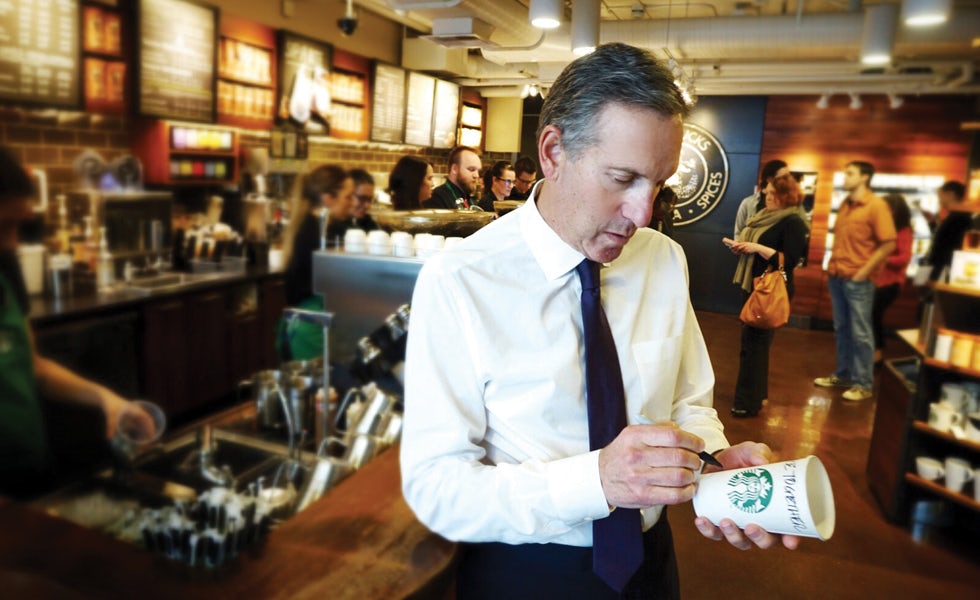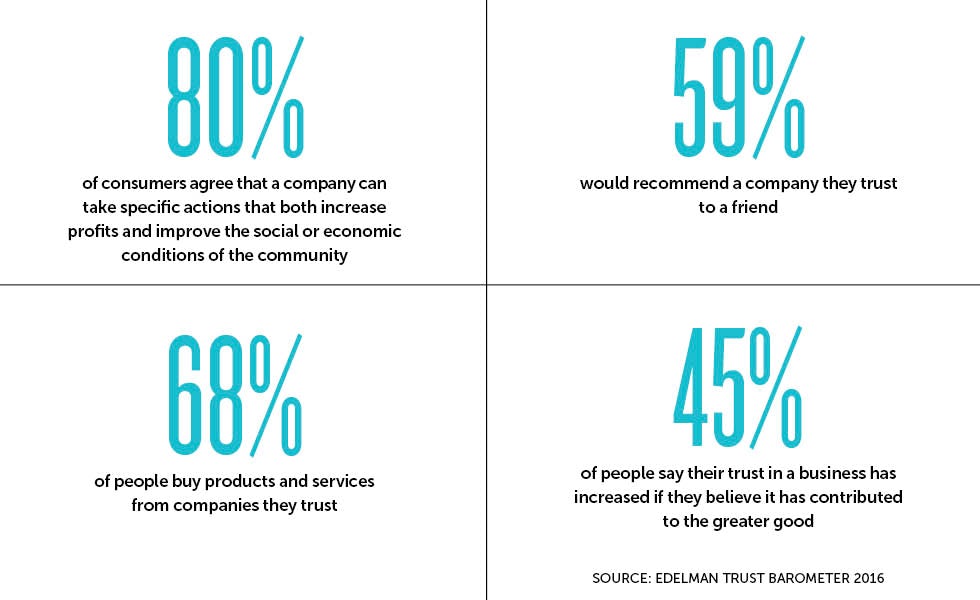Brands need to replace the outdated concept of CSR with a social purpose that is intrinsically linked to their core objectives.
Ben & Jerry’s has highlighted climate change and marriage equality, among other social issues
The concept of corporate social responsibility (CSR) is under the microscope like never before, as consumers are increasingly adept at seeing through insincere attempts by brands to appear to be doing good.
Lord Browne, the former BP CEO and one of the original proponents of CSR, reckons it is now a failed strategy because all too often it is separated from the core function of the business. Instead, brands are beginning to shift their focus onto ‘social purpose’: an effort to contribute to society that is aligned with their core activities.
“[CSR] started out as an attempt to improve businesses’ engagement with society, but it has become a sticking plaster over a company’s issues and an afterthought for the board on a Friday afternoon,” says Browne. “That is why CSR has become damaging.” (See Q&A, below.)
One such example is Volkswagen, which has been widely criticised for its response to last year’s emissions scandal, where it was found to have systematically manipulated tests so its cars’ emissions appeared lower than they really were.
In an attempt to restore faith, the car marque stated a renewed commitment to “transparent and responsible corporate governance” in its 2015 annual report, claiming that it would use its CSR initiatives to permanently boost “the company’s reputation and value in the long term”.
READ MORE: Mark Ritson – VW ad’s focus on keeping promises shows sheer contempt after emissions scandal
In reality, the approach highlights the widening gulf between CSR initiatives and a genuine social purpose that also fulfils the core objectives of a business. If the social purpose is not linked to the company’s overall strategy, products or services, the long-term benefit to the business will be minimal and the efforts will inevitably lose internal support.
Identify your social purpose
Research last year by Brand Learning, produced in partnership with Marketing Week, suggests the companies most capable of consistently growing profit are those that stand for more than simply making money.
“CSR has lost its credibility as a concept and we need to invent a new phrase, which is why social purpose as an evolution of CSR is very interesting,” says Hugh Milward, senior director of corporate, external and legal affairs at Microsoft. “The idea of CSR as pro-societal stuff you do in the corner [while you] let your business carry on doing what it does is CSR-wash.”
Microsoft’s micro:bit schools project embodies its mission to empower people using technology
But for social purpose to be credible, brands need to think about how their values and skill sets can contribute to society, while making sure senior leaders are on board and that the concept is economically sustainable.
Microsoft’s social purpose – set out by CEO Satya Nadella – is to empower every person and organisation on the planet to achieve more.
No mean feat, but the tech giant has a number of initiatives under way to achieve this aim. This year, for example, Microsoft worked with the BBC on the development of its ‘micro:bit’ project: a pocket-sized, codeable computer with motion detection, a built-in compass and Bluetooth technology, which is being given to every year seven pupil in the UK to encourage digital creativity.
Over the past five years the tech company has also run an apprenticeship programme helping 25,000 UK businesses fill technical skills gaps and become more efficient using Microsoft technology.
Milward argues that it is logical for Microsoft to invest in technology and empower people to use its products better, which shows how tightly social purpose is connected to business purpose. “If just by doing business you deliver pro-social outcomes then you have taken your social purpose one step further,” he adds.
Match purpose with profit
Gravy brand Bisto tapped into the issue of loneliness among the elderly with its Spare Chair Sunday campaign last September, part of the wider Bisto Together Project, launched in 2014. Running until December, the initiative encouraged families cooking a Sunday roast to link up with not-for-profit organisation Contact the Elderly and invite an older person for dinner.
“Contact the Elderly’s objective was to double its number of volunteers by 2020 and we helped them achieve that in three months, with over 5,500 people signing up,” says Helen Warren-Piper, Premier Foods’ marketing director for grocery.
“We genuinely ploughed something back into society and hit on a zeitgeist topic of loneliness among the elderly.”
Warren-Piper cannot sign off activity just because it feels good, which is why it is important that Bisto can directly link the campaign to its rising market share.
In December 2015, Bisto claimed an 80.3% share of the ambient gravy market, its highest point for five years, having increased by 4.1 share points year-on-year. The sales value of Bisto Best gravy, featured in its TV ad, grew 20% during the period.
Starbucks’ #RaceTogether campaign was attacked for cashing in on racial tension
It is important that any strategy has longevity and can evolve, so based on the success of the original vision, the 2016 iteration of the campaign will explore opportunities for hosting community-based meals.
Sam Hollis, head of planning at Good Agency, suggests social purpose should be driven by strategy and be a pillar of a brand’s purpose, which the whole business is built around.
“It gives consumers a reason to believe in you and belief is enormously powerful in creating loyalty and advocacy. Companies which demonstrate a richer emotional connection are more resilient to the competition,” he suggests.
This is supported by Edelman’s latest trust barometer, which shows 45% of people say their trust in a business increases if they believe it has contributed to the greater good. It is not something brands should overlook as the majority of people (80%) believe companies can take specific actions both to increase profits and improve the social or economic conditions of the community.
Ensure long-term sustainability
To make a difference over a sustained period, brands need to develop a strategy that is economically viable as well as credible. Consumer health business Reckitt Benckiser (RB), owner of brands including Durex and Dettol, has a ‘Better Business’ corporate strategy based on improving financial results, the environment and society.
The marketing team, for instance, is asked to create development objectives linked to this purpose, as well as to commercial targets.
“While we have many corporate-led activities that cut across all of our brands – traditional CSR – we see social purpose as a key driver of their communications and innovation strategies,” says RB head of innovation and sustainability Dave Challis. “It is important to us that these brand-led social purpose activities ladder up to our corporate purpose.”
Challis acknowledges that while RB’s social purpose programmes are intended to tackle health issues, they also help grow its brands. Each project begins with a clear brand purpose, looking at how to align the product portfolio “with unmet societal needs”.
The Co-operative worked with Kenyan communities to help set up tea plantation co-ops
In 2015, for example, Durex developed a safe sex emoji, which it launched in 43 markets. While driving social purpose, the campaign also provided the brand with exposure, the #CondomEmoji hashtag being mentioned in more than 140 countries on social media, while Durex’s educational YouTube video was viewed 10 million times.
Last year RB also developed Dettol’s Hygiene Curriculum, a three-year health and hygiene education programme for communities in India, which rolled out to 2,500 schools and reached 300,000 children.
While it may sound grandiose, helping customers improve their lives can have a positive impact on businesses’ commercial goals. Vitality Insurance, for example, saw a noticeable drop in claims after giving customers wearable technology to help them track their physical activity.
“We know physical activity is a significant determinant of health, so by increasing our members’ levels of physical activity and reducing the likelihood of them making a claim we are able to use the emerging savings to develop rewards for our members, so helping to sustain their physical activity,” says marketing director Keith Kropman.
Vitality Insurance believes its shared value model differs from standard CSR because it is designed to do good for customers, the business and wider society, with the majority of social activity concentrated on helping people make healthy choices.
Get leadership backing
To be truly embedded into a business, social purpose needs backing from a company’s leaders, shareholders and commercial functions.
“Anything we do has to support the business strategy,” says Ann Evans, head of social innovation at Danone Nutricia Early Life Nutrition. “If an activity were completely unrelated to the business it would be harder to get our directors to buy in.
“Everyone understands our mission, from the top to the most junior person, and we are measured in terms of how we’re delivering against our social targets. Social purpose is always at the front of our mind when we are working on strategy.”
Danone set up the €100m (£79m) Danone Eco System fund six years ago, which is intended to fund social and environmental projects that will become financially sustainable initiatives within three to five years.
Evans collaborates with a cross-functional team spanning marketing, finance and nutrition, looking at projects focused on employment and empowerment. One such long-term initiative is Healthy Eating for Young Children (HEY), a family learning community programme for children aged one to three, intended to improve the eating habits of families.
To evolve the concept for 2016, in September Danone will launch Early Years Nutrition Partnership (EYNP), a social enterprise in England pairing nurseries with nutritionists who will give advice on improving nutrition and hydration to the nursery teams.
At The Co-operative Group, meanwhile, any social initiative needs to be presented to a member council to ensure that all activity is aligned with the company’s principles – a protocol tied in with the company’s co-operative structure, which dates back to 1844.
The Co-operative supermarket has taken its model to tea plantations in Kenya to help local communities set up co-operatives there. The supermarket also strives to support its Fairtrade social purpose on a product level.
“The convenience market is really paying off for us, but we’re not abandoning the Fairtrade offer, despite the fact that there could be sourcing issues in smaller stores,” says head of brand Helen Carroll.
“We ensure that our range relates to our social purpose. We don’t start from a place of a marketing initiative or CSR angle. We believe in finding a better way to do business.”
Use purpose to attract talent
Having a credible social purpose can also help companies recruit new talent and retain staff.
Lord Browne says: “In a war for talent, it is essential that you appeal to people through the purpose of your company. Everyone, young and old, wants to work somewhere that aims to create a better world. Simply taking money from society is just not that exciting.”
To support staff development, pharmaceutical company GlaxoSmithKline (GSK) runs an annual volunteering programme enabling employees to take part in a fully paid three- to six-month assignment with one of its NGO partners worldwide. Since 2009, 550 employees have participated in the Pulse programme, equating to 80 volunteers a year.
“We believe a company’s social purpose is an important factor when jobseekers are considering their career options,” says Clare Griffin, GSK’s head of corporate responsibility and reporting. “We emphasise our social purpose and responsible business practices in our recruitment activities and feel this resonates with millennials.”
Whether it is attracting new talent, driving business growth or increasing consumer trust, brands that identify a genuine social purpose and implement a strategy to support it at all levels stand to benefit greatly and ultimately increase profit.
How does social purpose differ from CSR?
Social purpose has to be relevant to the company’s core business. All companies have to think about how to engage radically with society.
This means engaging with stakeholders on their agenda and adapting your business strategy accordingly.
The strategy should not just think about the supply chain or sourcing; it also needs to relate to all the people you interact with, both inside the company and outside of it.
How will this benefit businesses?
You can see a difference with companies that engage with their stakeholders in this way and include them in their decisions. Companies that do this make better returns in the long run. Studies have shown that the most inclusive companies achieve abnormal returns of more than 20% over a 10-year period compared to competitors.
An example would be Salesforce.com, which has consistently thought about including staff regardless of their background. They operate in exactly the same way for all stakeholders affected by their business.
How does connecting with society give companies a tangible competitive advantage?
Research has shown that the value at stake for companies in their relationship with society is roughly 30% of their value. Therefore a good relationship with society is not just nice to have – it is a key determinant of competitiveness. Connecting effectively can set companies apart in many ways, from reduced regulatory risk to enhanced reputation.
Does social purpose need to be driven from the top down?
It is essential that social purpose comes from the top, from the CEO, board and C-suite. They need to think about social purpose and to make this commitment to engagement clear throughout the organisation.
When social purpose misses the mark
Starbucks
Starbucks decided to tackle the race issues entrenched in American society in March 2015 by asking baristas to engage customers in conversation about equality over their cup of coffee. Baristas were encouraged to write #RaceTogether on cups, the intention being to “re-examine how we can create a more empathetic and inclusive society – one conversation at a time”. The reaction was fierce, with Starbucks being accused of capitalising on social tensions, prompting senior vice-president of communications Corey duBrowa to
delete his Twitter account and the campaign to end completely.
Bodyform
In March, Bodyform encouraged consumers to sign a petition asking Unicode, the consortium responsible for the emoji keyboard, to add six new emojis related to menstruation, or #Femojis. The campaign rationale was to “break down period taboos” and help girls discuss how they feel in emoji form. Despite gaining traction on social media, two months on Bodyform is over 14,000 signatures shy of its 50,000 petition goal. The campaign was not helped by the fact that a day earlier P&G-owned rival Always launched the latest iteration of its highly successful #LikeAGirl campaign, which focused on girls’ confidence in general and the kind of empowering emojis they would like to see.
McDonald’s
In February 2015, McDonald’s used its Super Bowl half time ad to promote its ‘Pay with Lovin’ campaign. In the run-up to Valentine’s Day, the fast food retailer allowed US customers to pay for their food with ‘random acts of love’, by giving out hugs, telling their family they loved them, or dancing on demand. While some people latched onto the idea of free food in exchange for a hug, others accused the fast food giant of failing to pay its staff fair wages, while offering free meals during the period was estimated to have cost McDonald’s $560 (£389) per restaurant.
Article Source: MarketingWeek.com







